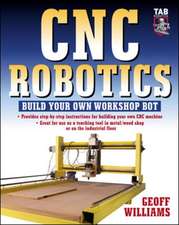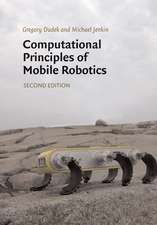Expert Aided Control System Design: Advances in Industrial Control
Autor Colin D. Tebbutten Limba Engleză Paperback – 11 ian 2012
Din seria Advances in Industrial Control
- 15%
 Preț: 643.34 lei
Preț: 643.34 lei - 23%
 Preț: 582.63 lei
Preț: 582.63 lei - 18%
 Preț: 783.98 lei
Preț: 783.98 lei - 18%
 Preț: 947.35 lei
Preț: 947.35 lei - 20%
 Preț: 568.24 lei
Preț: 568.24 lei - 15%
 Preț: 643.16 lei
Preț: 643.16 lei - 18%
 Preț: 899.21 lei
Preț: 899.21 lei - 18%
 Preț: 891.33 lei
Preț: 891.33 lei - 18%
 Preț: 740.57 lei
Preț: 740.57 lei - 18%
 Preț: 961.23 lei
Preț: 961.23 lei - 18%
 Preț: 955.08 lei
Preț: 955.08 lei - 15%
 Preț: 645.28 lei
Preț: 645.28 lei - 15%
 Preț: 638.43 lei
Preț: 638.43 lei - 18%
 Preț: 901.11 lei
Preț: 901.11 lei - 18%
 Preț: 1410.94 lei
Preț: 1410.94 lei - 18%
 Preț: 728.91 lei
Preț: 728.91 lei - 20%
 Preț: 1003.77 lei
Preț: 1003.77 lei - 18%
 Preț: 947.35 lei
Preț: 947.35 lei - 15%
 Preț: 643.34 lei
Preț: 643.34 lei - 15%
 Preț: 654.30 lei
Preț: 654.30 lei - 18%
 Preț: 950.52 lei
Preț: 950.52 lei - 15%
 Preț: 644.30 lei
Preț: 644.30 lei - 18%
 Preț: 1393.09 lei
Preț: 1393.09 lei - 18%
 Preț: 950.21 lei
Preț: 950.21 lei - 18%
 Preț: 949.90 lei
Preț: 949.90 lei - 18%
 Preț: 949.42 lei
Preț: 949.42 lei - 18%
 Preț: 950.52 lei
Preț: 950.52 lei - 18%
 Preț: 1113.71 lei
Preț: 1113.71 lei - 15%
 Preț: 650.04 lei
Preț: 650.04 lei - 15%
 Preț: 644.95 lei
Preț: 644.95 lei - 18%
 Preț: 950.33 lei
Preț: 950.33 lei - 18%
 Preț: 948.61 lei
Preț: 948.61 lei - 18%
 Preț: 1112.60 lei
Preț: 1112.60 lei - 15%
 Preț: 644.63 lei
Preț: 644.63 lei - 18%
 Preț: 953.20 lei
Preț: 953.20 lei - 18%
 Preț: 945.62 lei
Preț: 945.62 lei - 15%
 Preț: 640.88 lei
Preț: 640.88 lei - 15%
 Preț: 640.88 lei
Preț: 640.88 lei - 20%
 Preț: 650.92 lei
Preț: 650.92 lei - 18%
 Preț: 1112.60 lei
Preț: 1112.60 lei - 20%
 Preț: 998.36 lei
Preț: 998.36 lei - 15%
 Preț: 643.34 lei
Preț: 643.34 lei - 18%
 Preț: 948.92 lei
Preț: 948.92 lei - 18%
 Preț: 1381.43 lei
Preț: 1381.43 lei - 15%
 Preț: 651.51 lei
Preț: 651.51 lei - 15%
 Preț: 647.08 lei
Preț: 647.08 lei - 20%
 Preț: 563.66 lei
Preț: 563.66 lei - 18%
 Preț: 998.03 lei
Preț: 998.03 lei - 18%
 Preț: 1225.79 lei
Preț: 1225.79 lei
Preț: 380.07 lei
Nou
Puncte Express: 570
Preț estimativ în valută:
72.73€ • 75.14$ • 60.50£
72.73€ • 75.14$ • 60.50£
Carte tipărită la comandă
Livrare economică 19 martie-02 aprilie
Preluare comenzi: 021 569.72.76
Specificații
ISBN-13: 9781447121060
ISBN-10: 1447121066
Pagini: 156
Ilustrații: XVIII, 134 p.
Dimensiuni: 155 x 235 x 8 mm
Greutate: 0.23 kg
Ediția:Softcover reprint of the original 1st ed. 1994
Editura: SPRINGER LONDON
Colecția Springer
Seria Advances in Industrial Control
Locul publicării:London, United Kingdom
ISBN-10: 1447121066
Pagini: 156
Ilustrații: XVIII, 134 p.
Dimensiuni: 155 x 235 x 8 mm
Greutate: 0.23 kg
Ediția:Softcover reprint of the original 1st ed. 1994
Editura: SPRINGER LONDON
Colecția Springer
Seria Advances in Industrial Control
Locul publicării:London, United Kingdom
Public țintă
ResearchCuprins
1 Artificial Intelligence and Control System Design.- 1.1 Introduction.- 1.2 Why Use an Expert System?.- 1.3 Applications of Expert Systems in CACSD.- 1.4 Description of the Design System.- 1.5 Notation.- 2 The CACSD Method.- 2.1 Introduction.- 2.2 Notation.- 2.3 Summary of Factorization Theory.- 2.4 Computing the Coprime Matrix Fractions.- 2.5 Diagonal Factorization.- 2.6 The Diagonal Factorization Algorithm.- 2.7 The QSTEP Parameter.- 2.8 The Closed Loop Poles.- 2.9 The S Domain.- 2.10 Summary.- 3 Implementation of the CACSD Package.- 3.1 Introduction.- 3.2 Generating the Quadratic Programming Problem.- 3.3 Representing the Linear Constraints.- 3.4 Solving the Quadratic Programming Problem.- 3.5 The QPSOL Algorithm.- 3.6 Ancillary Functions of the CACSD Package.- 3.7 Summary.- 4 The Expert System.- 4.1 Introduction.- 4.2 The User Interface and Philosophy.- 4.3 Explaining the Design Language and Methodology.- 4.4 Presentation of the Design Status.- 4.5 Formulating the Design Specifications.- 4.6 Expanding the Scope of the CACSD Package.- 4.7 Optimizing the Use of the CACSD Subroutines.- 4.8 Summary.- 5 Implementation of the Expert System.- 5.1 Introduction.- 5.2 Selection of the Expert System Shell.- 5.3 Communication with External Programs.- 5.4 Database Facilities.- 5.5 Structure of the Expert System.- 5.6 Summary.- 6 Sample Design Sessions.- 6.1 Introduction.- 6.2 Example 1: A Mine Milling Plant.- 6.3 Example 2: A Gyroscope.- 6.4 Other Examples.- 6.5 Summary.- 7 Use of the Expert System.- 7.1 Introduction.- 7.2 The Undergraduate Control System Design Project.- 7.3 The Postgraduate Control System Design Project.- 7.4 Summary.- 8 Implementing the Controller.- 8.1 Introduction.- 8.2 Full Controller Implementation.- 8.3 Reduced Order Controller Estimation.- 8.4 Examplesof Controller Implementation.- 8.5 Summary.- 9 Conclusions.- Appendix A MV-CXS Specifications.- A.l Requirements for the Computer.- A.2 Requirements for the Plant.- A.3 The MV-CXS Command Language Specification.- A.3.1 Commands to Select a Response.- A.3.2 Graphics Commands.- A.3.5 Miscellaneous Commands.- Appendix B The CACSD Package Interface.- Appendix C The MV-CXS Student Design Project Instructions.- References.








